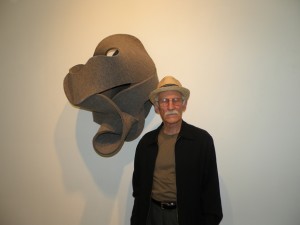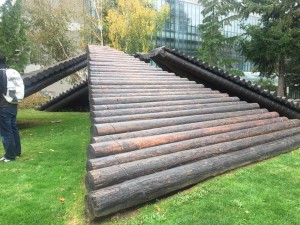My initial reaction to this sculpture was a thought of a comparison to the famous Egyptian pyramid.
The few significant differences that differ from each other, both model resembles the shape of each sides going towards in, making a three-dimensional triangular shape. Because of its wide size and length, the instant gratification thought of climbing on top of the sculpture was irresistible. For that it will satisfy my imagination of being on top of the world and seeing people from a birds like perspective.
This vision that I desirably seek out, is a metaphor that I believe in, in which I want to excel any goals that I am currently working on, being the “top” dog out of everyone. Hence why I seek out climbing to the top of the log ramp. In general, the sculpture just stimulates my adrenaline to step out of my comfort zone. Much like how stimulating it is, to climb up the ramp. I feel more empowered, confident, and bold every time I observe at the very bottom of the log to the top. It made me appreciate the simplicity of this art as it can signify countless meaning behind it. The more I stare at it, the more thoughts that is being produce, questioning myself what is the true meaning behind this three-dimensional triangular shape. Nobody will ever inquire the true nature of this work but the creator itself.
Artist:
Lloyd Hamrol was born in 1937, San Francisco, California and raised in Los Angeles. He is best known for doing big installations and site work that tends to be interactive.
Sculpture:

About the Sculpture
- Reconstructed in 1983 and 1995
- Made out of cedar logs
- Anchored in ground by concrete caissons
- 8.6′ h. x 40′ w
- Positioned so the viewer can climb up and see among mother things,
- An imaginary circle inscribed within the center.
- The location was selected because it was by the environmental science building, and the artist intended his work to have a connection to nature.
History:
This sculpture present itself to offer as a ceremonial shelter. Lloyd Hamrol vision behind the ramp was intentionally built to be interactive for anyone to climb, for as it evoke reference to ceremonial architecture, protecting enclosure, and the natural resource of the Northwest. The materials that were made together, could be best believe to be transpire by how the location was establish, Bellingham, Washington. This was establish in 1852, when two Californians was in search for a location to start a Lumber mill. Although the history of Bellinghams logging industry was not Hamrols intent in making the sculpture, it is still a link to the past with the use of logs.
How it relates to us today?
How the Sculpture collection relate to us today is the environmental value that both the sculpture and students at Western Washington University have. According to what Lloyd Hamrol stated the log ramp symbolized an “eruption of the earth surface or a pealing back of the earth”. It was intentionally built to be interactive, for anyone to climb. This evoke reference to ceremonial architecture, protecting enclosure, and the natural resources of the Northwest.
A lot of people, are very aware of their environmental surrounding, striving their best ability to protect it. This means preventing people from littering, as it can damage the ecosystem, our water source, and the plants around us. By doing so, people at Western have different kind of bins, with different labels to indicate what goes in to what.
Because of small actions like this, it can create a big difference. They’re helping everyone to be engage by instructing others where it is appropriate to dispose things. Then in return, the natural resources around them are more cleaner and aesthetically prettier. Thus the similarities between the two ties down to spreading awareness.
Credit:
Johnny Phan: Worked on the entire post layout, adding further information that is required.
Elisabeth Minor: Worked on researching further information.
Donna Ganbaatar: Taking all the necessary pictures of the sculpture.
Citation:
Lieb, By Emily. “HistoryLink.org.” Bellingham. N.p., 20 Aug. 2006. Web. 31 Oct. 2016.
“LLOYD HAMROL Sculpture about.” LLOYD HAMROL Sculpture. N.p., 2015. Web. 31 Oct. 2016
.
“Western Gallery.” Western Gallery. N.p., n.d. Web. 31 Oct. 2016.











October 7, 2024 at 9:11 pm
+ В конфликте с родителями, общение холодное или его нет вовсе
+ Испытываете эмоциональное и/или физическое выгорание
+ Больше не испытываете эмоций
+ Чувствуете, что страсть и любовь ушли из отношений
+ Много делаете и стараетесь, но результаты уже не приходят так, как раньше
+ Больше не испытываете эмоций
+ Не можете построить долгие отношения, проще без
них, партнёры всё время не те
+ Делаете результаты через преодоление и страдания
+ Одиноки, нет друзей и сложно строить отношения с людьми
+ В конфликте с родителями, общение холодное или его нет
вовсе
+ На грани развода
+ Больше не испытываете эмоций
+ Не можете построить долгие отношения, проще
без них, партнёры всё время не те
+ Тащите всё на себе, нет
времени на жизнь
+ Испытываете эмоциональное и/или физическое
выгорание
https://batmanapollo.ru/#